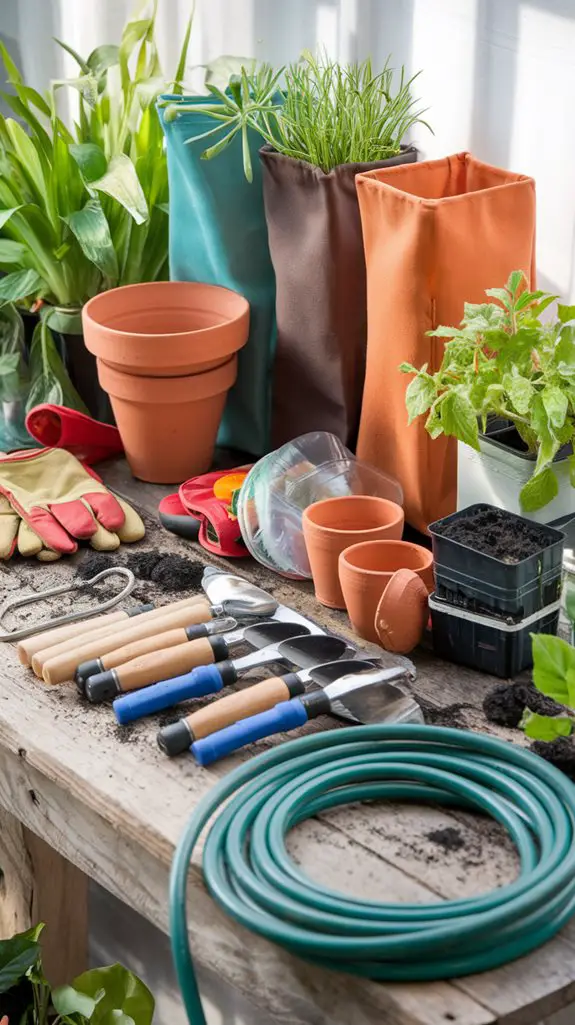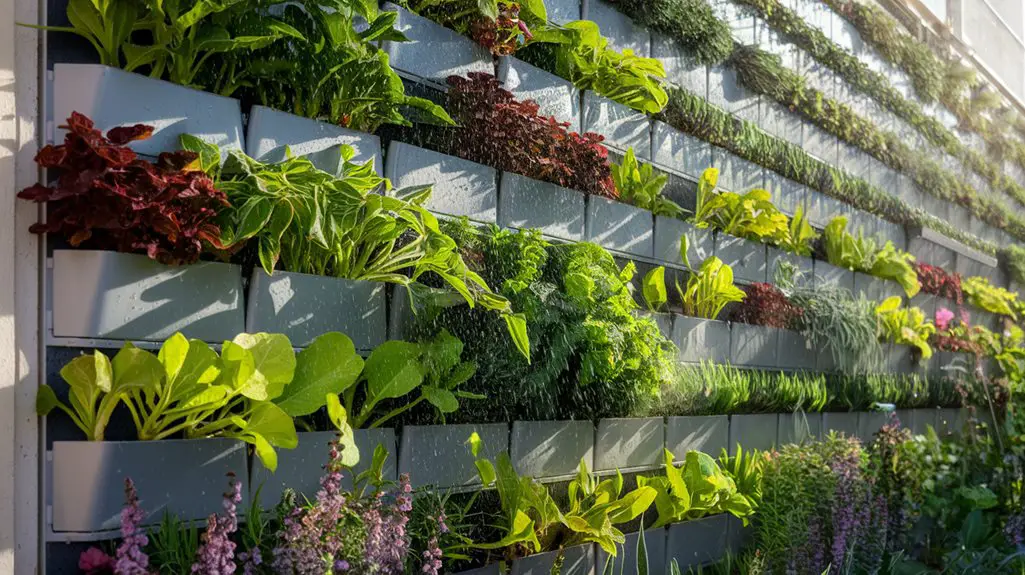If you're looking to maximize your gardening space, a vertical garden system could be your solution. These systems not only save space but also enhance your outdoor aesthetics. You'll need to evaluate your available area and decide which structure fits best. Additionally, selecting the right plants is essential for a successful vertical garden. Understanding these fundamentals will set the stage for creating a thriving green environment, but there's more to take into account as you plan your vertical oasis.
Understanding Vertical Gardening
Vertical gardening is an innovative approach that transforms limited spaces into lush green landscapes. This method allows you to maximize vertical surfaces, utilizing wall-mounted systems, trellises, and hanging planters.
By doing so, you can cultivate a variety of plants, including herbs, vegetables, and ornamental flowers. Understanding the principles of vertical gardening involves knowing plant selection, light requirements, and irrigation methods.
You'll need to evaluate the weight of the soil and plants, ensuring your structure can support them. Additionally, maintaining proper airflow and drainage is essential to prevent mold and root rot. Maximizing small areas through vertical gardening also encourages creative design and resourceful use of materials.
With careful planning and assessment, vertical gardening can enhance aesthetics, improve air quality, and even contribute to urban biodiversity in your limited space.
Choosing the Right Vertical Garden System
When selecting a vertical garden system, it's crucial to take into account your specific space, plant choices, and maintenance needs. Each of these factors considerably influences your overall success and satisfaction.
Here are three key considerations:
- Space Availability: Assess your wall or area dimensions to determine the appropriate size and structure of your vertical garden. Confirm it fits without overcrowding.
- Plant Selection: Choose plants that thrive in vertical settings. Consider light requirements, growth habits, and compatibility with each other.
- Maintenance Requirements: Evaluate how much time and effort you can dedicate to upkeep. Some systems require more frequent watering and care than others. Additionally, incorporating creative vertical garden ideas can enhance both aesthetics and functionality in small spaces.
Essential Tools and Materials

Creating a vertical garden requires a few vital tools and materials to guarantee a successful setup.
First, you'll need a sturdy frame or structure, which can be made from wood, metal, or PVC. Next, gather planting containers or pockets that fit your chosen system.
You'll also need high-quality potting soil and a variety of plants suitable for vertical growth. Don't forget tools like a trowel, gardening gloves, and scissors for maintenance.
Additionally, a watering can or drip irrigation system is essential for consistent moisture. Finally, consider supports or trellises for climbing plants.
To make your vertical garden even more manageable, consider using low-maintenance plants that thrive in vertical setups.
With these tools and materials in hand, you'll be ready to create a thriving vertical garden that enhances your space.
Plant Selection for Vertical Gardens
Choosing the right plants for your vertical garden is key to achieving a vibrant and healthy display.
Consider the following factors to guarantee your selection thrives in a vertical system:
- Light Requirements: Assess the light conditions of your space. Choose shade-tolerant plants for low-light areas and sun-loving varieties for brighter locations.
- Growth Habit: Opt for plants with suitable growth habits. Climbing or trailing species, like ivy or sweet potato vine, work well in vertical setups, allowing efficient use of space.
- Water Needs: Select plants with similar watering requirements. Grouping plants with similar moisture needs simplifies maintenance and promotes healthier growth. Additionally, incorporating vertical gardening accessories can significantly enhance growth and overall plant health.
Maintenance Tips for a Thriving Vertical Garden

To guarantee your vertical garden flourishes, regular maintenance is essential.
Start by monitoring moisture levels; most vertical systems require watering every few days, especially in warmer months. Check for drainage to prevent root rot.
Use a balanced, water-soluble fertilizer every four to six weeks to supply necessary nutrients. Prune dead or yellowing leaves promptly to encourage healthy growth and airflow.
Inspect for pests like aphids or spider mites, treating infestations with organic insecticidal soap if needed. Rotate your plants occasionally to ascertain even light exposure.
Finally, clean your vertical structure and remove debris to prevent diseases. Staying consistent with these practices will help maintain a vibrant and productive vertical garden. Additionally, consider incorporating eco-friendly vertical gardening techniques to boost sustainability in your gardening efforts.
Creative Vertical Garden Design Ideas
While exploring vertical garden design, you'll find a myriad of creative options that can transform any space into a lush oasis.
Here are three ideas to take into account:
- Living Wall Panels: Utilize modular panels that can house various plants, creating an eye-catching focal point. Choose varieties that thrive in your climate for peak growth.
- Hanging Planters: Suspend planters from ceilings or walls to maximize space. Experiment with different heights and arrangements to add dimension and interest.
- Repurposed Materials: Get inventive by using old pallets, crates, or gutters. These materials can serve as unique planters, adding character while being eco-friendly. Additionally, consider incorporating DIY vertical garden designs that cater to your specific space and preferences for a personalized touch.
Conclusion
In summary, cultivating a vertical garden is like nurturing a living tapestry; each plant contributes to a vibrant, interconnected design. By carefully evaluating your space, choosing the right system, and selecting suitable plants, you can create a thriving green oasis. Consistent maintenance and attention to detail will guarantee your vertical garden flourishes, bringing life and beauty to your environment. Embrace the journey of vertical gardening, and watch your passion for plants blossom in every direction.




